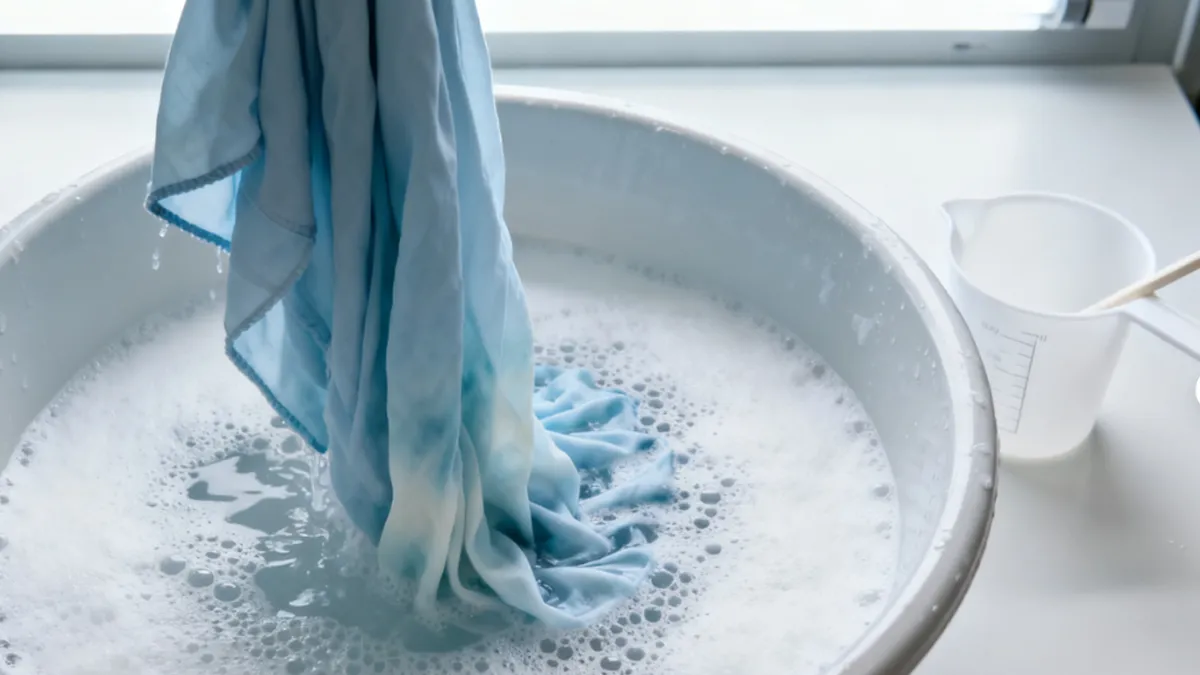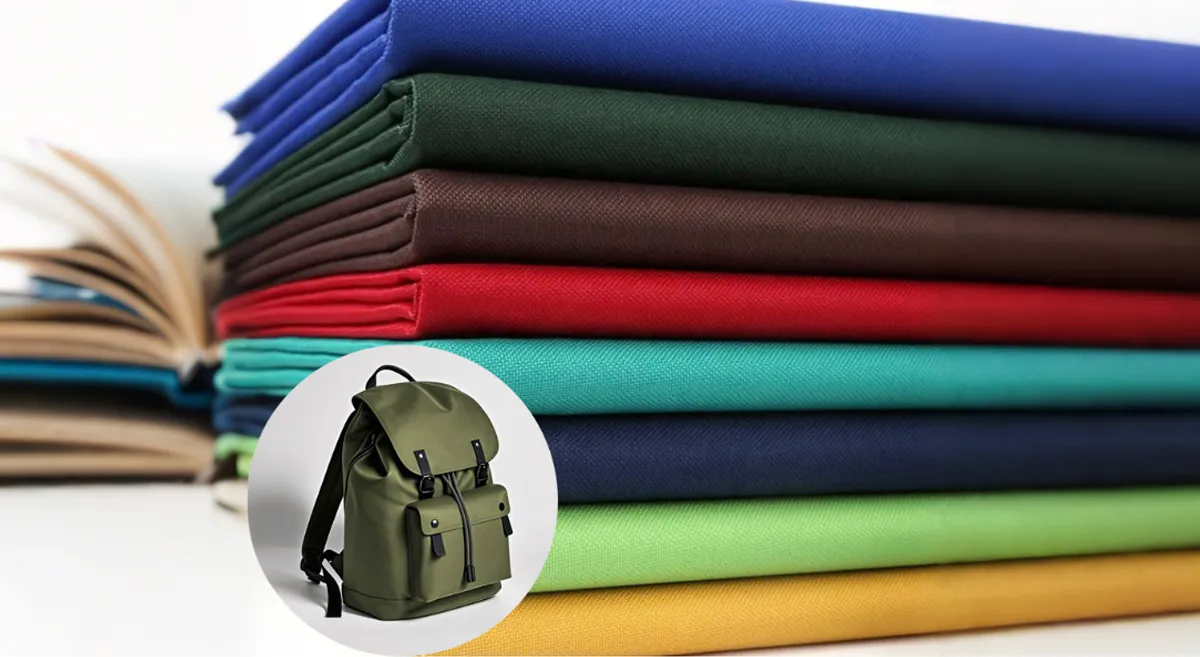You might wonder, can i bleach nylon fabric without ruining it? The answer is yes, but you need to use the right approach. Nylon reacts differently to bleach than other fabrics. If you use the wrong type or leave it on too long, you risk weakening the fibers or turning the fabric yellow. Textile experts warn that nylon is not as tough against bleach as polyester, so you need to work carefully for the best results.

Key Takeaways
- Use oxygen-based bleach for nylon. It is soft and keeps the fabric strong.
- Always test bleach on a hidden spot first. This helps stop damage to your favorite things.
- Soak nylon in the bleach mix for 30 minutes to 2 hours. Do not go over 2 hours or the fabric may get weak.
- Rinse the fabric right away in cold water after soaking. This stops the bleach and keeps the fibers safe.
- Look at the care label before you use bleach. It tells you what is safe for your nylon item.
- Do not use chlorine bleach or hydrogen peroxide. These can make nylon turn yellow and get ruined.
- Be gentle with the fabric while you work. Do not twist or wring it so the fibers stay whole.
- Let nylon air dry away from sunlight. This stops fading and keeps the fabric strong.
Can I Bleach Nylon Fabric?
Is It Safe?
You probably ask yourself, can i bleach nylon fabric without causing damage? The answer depends on how you do it. Nylon is not as tough as polyester when it comes to bleach. If you use bleach for too long or pick the wrong type, you might see yellow stains or weak spots. Research shows that nylon can handle bleaching, but only if you follow the right steps. Always test bleach on a small, hidden part of the fabric first. This way, you avoid ruining your favorite bag or jacket.
If you want to stay safe, follow these tips:
- Use oxygen bleach instead of chlorine bleach.
- Mix ¼ cup of oxygen bleach with one gallon of warm water.
- Pre-treat any stains before you start bleaching.
- Submerge the nylon and gently move it around.
- Let it soak for 30 minutes to 2 hours.
- Rinse with cold water and use mild detergent.
- Air-dry the fabric away from sunlight.
- Always check a small area first.
Before you start, look at the care label. If you see an open triangle, any bleach is safe. A triangle with diagonal lines means only non-chlorine bleach is okay. A solid triangle with an ‘X’ tells you not to bleach at all.
When to Bleach Nylon
You might wonder when it makes sense to bleach nylon. Sometimes, nylon turns yellow over time. Bleaching can help restore the color. Textile professionals recommend bleaching nylon only when you see yellowing or stubborn stains that won’t go away with regular washing.
Here’s a quick look at when and how experts suggest bleaching nylon:
| Condition for Bleaching | Recommended pH Range | Available Chlorine Content (ppm) | Treatment Time (minutes) |
|---|---|---|---|
| Yellowed fabric | 7.70 – 8.70 | 200 – 800 | 15 – 40 |
If you follow these guidelines, you can bleach nylon safely and get good results.
Risks to Nylon Fibers
Bleaching nylon comes with risks. If you use the wrong bleach or leave it on too long, you might damage the fabric. Nylon fibers can get weak, and the color can turn yellow. You could end up with holes or thin spots in your bag or clothes.
Tip: Always check the care label and test bleach on a hidden area. This helps you avoid costly mistakes.
Before you ask again, can i bleach nylon fabric for tough stains, remember that careful testing and gentle handling make all the difference. If you rush or skip steps, you risk ruining your nylon item. Take your time, follow safety tips, and your nylon will look fresh without damage.
Bleaching Agents for Nylon
If you want to bleach nylon, you need to pick the right bleach. Some bleaches are safe, but others can ruin nylon fast. Not every bleach works the same way on nylon. Some can clean and make nylon brighter. Others can hurt the fabric quickly.
Safe Bleach Options
Oxygen-Based Bleach
Oxygen-based bleach is a good choice for nylon. You might see it called “color-safe bleach” or “non-chlorine bleach” in stores. It is gentle and works well for nylon.
- Oxygen bleach is not as strong as chlorine bleach.
- It helps remove stains and makes colors lighter.
- It does not hurt nylon fibers, so the fabric stays strong.
You can use oxygen bleach on most nylon things. It is good for yellow spots or hard stains. Always read the package and follow the directions.
Sodium Chlorite
Sodium chlorite is also safe for nylon. Textile experts use it for cleaning nylon in special places. It can make nylon bright again without making it weak. If you use sodium chlorite, make sure you are in a place with fresh air. Always follow safety rules.
Agents to Avoid
Chlorine Bleach
Chlorine bleach, or sodium hypochlorite, is too strong for nylon. Even a little bit can cause big problems. Here is what can happen if you use chlorine bleach on nylon:
Chlorine bleach is very harsh and can hurt nylon. The color can fade fast. The fabric can get weak and holes may show up. When you wash it later, the weak spots can break. You might find new holes after washing.
That is why you should never use chlorine bleach on nylon.
Hydrogen Peroxide
Hydrogen peroxide may seem gentle, but it can also hurt nylon. Studies show that:
- Hydrogen peroxide, with UV light, changes nylon fibers.
- The fabric gets weaker and loses strength.
- The fibers stretch more and do not snap back.
- The fabric may not go back to its shape after folding.
So, hydrogen peroxide is not good for nylon. It can make nylon weak and change how it feels.
Tip: Always look at the bleach label. If it says “chlorine” or “hydrogen peroxide,” do not use it on nylon.
Here is a table to help you remember:
| Bleaching Agent | Safe for Nylon? | Notes |
|---|---|---|
| Oxygen-Based Bleach | Yes | Gentle, effective, keeps fibers strong |
| Sodium Chlorite | Yes | Use with care, follow safety tips |
| Chlorine Bleach | No | Causes fading, holes, weak fibers |
| Hydrogen Peroxide | No | Weakens and stretches fibers |
Picking the right bleach is important. Use oxygen-based bleach or sodium chlorite. Do not use chlorine bleach or hydrogen peroxide. This will help your nylon last longer and look nice.
Preparing Nylon for Bleaching
Pre-Treatment
Before you start bleaching, you need to get your nylon fabric ready. Pre-treatment helps you avoid surprises and keeps your fabric safe. You might wonder, why bother with extra steps? Textile experts say that pre-treatment removes dirt, oils, and other stuff that can mess up the bleaching process. Clean fabric lets the bleach work better and helps you get even results.
Here’s what you should do before you reach for the bleach:
- Wash your nylon item with mild detergent to remove surface dirt and oils.
- Rinse it well to make sure no soap stays behind.
- Check for stains or spots that need extra attention. Treat them with a stain remover if needed.
- Let the fabric dry a bit, but keep it damp for bleaching.
Inspect and Test Fabric
Now, take a close look at your nylon. You want to spot any weak areas, holes, or loose threads. If you see damage, fix it before you bleach. This step saves you from making small problems worse.
Next, always test the bleach on a hidden part of the fabric. Dab a little of your bleach solution on a seam or inside pocket. Wait 10-15 minutes. If the color stays the same and the fabric feels strong, you’re good to go. If you see fading, yellowing, or weak spots, stop and try a gentler method.
Tip: Pre-treatment isn’t just about cleaning. It also helps the fabric soak up the bleach evenly. This means you get a brighter, cleaner look without patchy spots.
Supplies Needed
You don’t need fancy tools to bleach nylon, but you do need the right supplies to stay safe and get good results. Here’s a checklist to help you get started:
- Protective gloves: Choose waterproof gloves made of nitrile or rubber. These keep your hands safe from bleach.
- Eye protection: Wear safety glasses or goggles. Bleach can splash, and you don’t want it near your eyes.
- Ventilation: Work in a space with fresh air. Open windows or use a fan to move air around.
- Bleach: Pick an oxygen-based bleach or sodium chlorite, not chlorine bleach.
- Measuring cup: You’ll need this to mix the right amount of bleach and water.
- Large basin or bucket: Use this to soak your nylon item.
- Mild detergent: You’ll use this to wash out the bleach after soaking.
- Clean towels: These help you dry your fabric gently.
Always remember to dilute your bleach with water before using it. Never pour bleach straight onto nylon. This can cause damage fast.
If you ever ask yourself, can i bleach nylon fabric without ruining it, just remember that careful prep and the right supplies make all the difference. Take your time, follow these steps, and you’ll set yourself up for success.
Bleaching Nylon Fabric: Step by Step
Mix Bleach Solution
Start by mixing your bleach solution. You want to get the ratio right so you do not damage your nylon. For most nylon fabrics, use a 5:1 ratio of water to bleach. That means you add five parts water for every one part of oxygen-based bleach. If you use sodium chlorite, follow the instructions on the package. Always use cold or lukewarm water. Hot water can make the bleach work too fast and hurt the fabric.
Tip: Never pour bleach straight onto the nylon. Always mix it with water first. This keeps your fabric safe and helps the bleach spread evenly.
Here is a quick recipe you can follow:
- Pour 5 cups of water into a large basin.
- Add 1 cup of oxygen-based bleach.
- Stir the mixture until the bleach dissolves.
If you ever ask, can i bleach nylon fabric without ruining it, the answer depends on careful mixing. The right ratio protects your nylon and gives you the best results.
Soak and Agitate
Now you are ready to soak your nylon item. Place the fabric in the bleach solution. Make sure it is fully covered. Let it soak for 30 minutes to 2 hours. The time depends on how stained or yellow the fabric is. Do not leave it in longer than 2 hours. Too much soaking can make the nylon weak.
Check out this table for safe soak times:
| Soaking Agent | Maximum Soak Time | Implications |
|---|---|---|
| Oxygen-Based Bleach | 2 hours | Safe for nylon, gentle on fibers |
| Sodium Chlorite | 2 hours | Effective, but follow safety tips |
| Chlorine Bleach | 5 minutes | Risk of fabric damage increases with longer soaking |
While your nylon soaks, gently move it around every 10-15 minutes. This helps the bleach reach every part of the fabric. You do not want streaks or spots. Regular stirring keeps the color even and bright.
- Stir the fabric gently with a plastic spoon or your gloved hand.
- Move the fabric around so all areas get the same amount of bleach.
- Do not scrub or twist the nylon. Gentle movement is enough.
Note: Agitation is important. It stops streaks and helps the bleach work everywhere. Be gentle to avoid damaging the fibers.
Rinse and Dry
When the soaking time is up, take the nylon out of the bleach solution right away. Rinse it under cold running water. Cold water stops the bleach from working and keeps the fabric from getting damaged. Rinse until the water runs clear. This removes all the bleach and keeps your nylon strong.
Here are some tips for rinsing:
- Rinse the fabric in cold water as soon as you remove it from the bleach.
- Keep rinsing until you do not see any more suds or smell bleach.
- If your nylon is white, you can use warm water and then wash it with a mild powder detergent.
Tip: Rinsing right away is the best way to stop bleach damage. Cold water works fast to protect your nylon.
After rinsing, gently squeeze out extra water. Do not wring or twist the fabric. Lay the nylon flat on a clean towel or hang it up to air dry. Keep it out of direct sunlight. Sunlight can make nylon yellow or weak after bleaching.
If you follow these steps, you will get a clean, bright nylon item without damage. Remember, patience and gentle handling give you the best results.
Mistakes to Avoid
Wrong Bleach Use
You might think all bleach works the same way, but that’s not true for nylon. If you grab chlorine bleach or hydrogen peroxide, you risk ruining your fabric. These strong chemicals can eat away at nylon fibers, causing holes, fading, or yellow stains. Always check the label before you start. Look for oxygen-based bleach or sodium chlorite. These are gentle and safe for nylon.
Here’s a quick checklist to help you pick the right bleach:
- Read the care label on your nylon item.
- Choose oxygen-based bleach or sodium chlorite.
- Avoid chlorine bleach and hydrogen peroxide.
- Test your bleach on a hidden spot first.
If you use the wrong bleach, you might see your favorite bag or jacket fall apart after just one wash. Don’t let that happen. Take a minute to double-check your supplies.
Over-Soaking
You might think soaking nylon longer will make it cleaner. That’s not true. If you leave nylon in bleach for too long, you can damage the fibers. Nylon is not as tough as polyester. Prolonged exposure to bleach can make nylon yellow and weak. The fabric might start to break down, and you could end up with thin spots or holes.
Nylon needs gentle care. Set a timer when you soak your fabric. Most nylon items only need 30 minutes to 2 hours in the bleach solution. If you forget and leave it longer, you risk ruining the fabric’s strength and color.
Tip: Always follow the recommended soak time. If you’re unsure, check the instructions on your bleach or ask a textile expert.
Skipping Rinse
Rinsing is a step you can’t skip. After bleaching, you need to wash out all the bleach. If you leave bleach on nylon, it keeps working and can damage the fibers. You might see yellow stains or feel the fabric get rough over time. Heat from drying or ironing can make things worse.
Rinsing thoroughly is essential to ensure that bleach is completely removed. Residue can weaken fabric integrity over time and potentially cause yellowing when exposed to heat.
Make sure you rinse your nylon item in cold water until the water runs clear. This stops the bleach and keeps your fabric safe. If you skip this step, you risk ruining your nylon, even if you used the right bleach and soaked it for the right amount of time.
Here’s a simple rinse routine:
- Remove the nylon from the bleach solution.
- Rinse under cold running water.
- Keep rinsing until you don’t smell bleach or see suds.
- Gently squeeze out extra water—don’t wring or twist.
If you remember to rinse, your nylon will stay strong and look fresh for a long time.
Ignoring Care Labels
You might feel tempted to skip reading the care label on your nylon item. Maybe you think you already know how to wash it. Maybe you just want to get the job done fast. But ignoring the care label is one of the biggest mistakes you can make when bleaching nylon.
Care labels give you important information. They tell you what your fabric can handle. Some nylon items can take gentle bleach. Others cannot handle any bleach at all. If you miss this step, you risk ruining your favorite bag, jacket, or backpack.
Let’s look at what you might see on a care label:
| Symbol | What It Means | What You Should Do |
|---|---|---|
| 🔺 | Any bleach is safe | You can use bleach if needed |
| 🔺⟋⟍ | Only non-chlorine bleach | Use oxygen-based bleach only |
| ❌🔺 | Do not bleach | Avoid all bleach |
Tip: Always check the label before you start. If you see a triangle with an “X,” put the bleach away.
Ignoring care labels can lead to problems like:
- Yellow stains that do not wash out
- Weak or thin spots in the fabric
- Holes that appear after washing
- Faded colors or strange textures
You do not want to see your nylon item fall apart just because you missed a small symbol. Take a minute to read the label. It saves you time and money in the long run.
Here’s a quick checklist to help you:
- Find the care label inside your nylon item.
- Look for bleach symbols or written instructions.
- Follow the directions exactly.
- If you are not sure, test bleach on a hidden spot first.
Sometimes, care labels use words instead of symbols. You might see “No bleach,” “Non-chlorine bleach only,” or “Hand wash.” Always follow these instructions. They are there to protect your fabric.
Note: Manufacturers test their products before they add care labels. They know what works best for each item.
If you ignore the care label, you take a big risk. You might save a few minutes now, but you could lose your nylon item forever. Make checking the care label your first step every time you clean or bleach nylon. Your fabric will thank you!
Tips for Best Results
Gentle Handling
You want your nylon to last, so treat it with care. After bleaching, nylon can feel a bit more delicate. Handle it gently when you move it from the bleach solution to the rinse. Don’t twist or wring the fabric. Instead, press out the water softly with your hands. This helps keep the fibers strong and stops them from stretching out of shape.
If you need to move your nylon item, support it from underneath. Nylon can stretch if you let it hang while wet. Lay it flat on a towel before you carry it. This simple step keeps your bag, jacket, or backpack looking new.
Tip: Always use gloves when handling bleach and wet nylon. Your hands stay safe, and your fabric stays clean.
Air Drying
Drying nylon the right way makes a big difference. Skip the dryer. High heat can damage nylon fibers and cause shrinkage or yellowing. Instead, air drying works best.
Here’s how you can do it:
- Lay your nylon item flat on a clean, dry towel. This helps it keep its shape.
- Reshape the item while it’s damp. Smooth out any wrinkles or folds.
- Place the towel and nylon in a well-ventilated area. Fresh air speeds up drying.
- Keep your nylon away from direct sunlight. Sunlight can fade colors and weaken the fabric.
- Avoid hanging nylon to dry. Hanging can stretch the fabric and cause it to lose its shape.
A quick table to help you remember:
| Drying Method | Nylon Safe? | Notes |
|---|---|---|
| Air Dry Flat | ✅ | Best for shape and strength |
| Hang to Dry | ❌ | Can stretch and distort |
| Tumble Dry (Heat) | ❌ | Can shrink or yellow fabric |
| Sunlight Drying | ❌ | Fades color, weakens fibers |
Note: Nylon dries quickly, so you won’t wait long!
Post-Bleach Care
Taking care of your nylon after bleaching helps it last longer. You don’t need fancy products—just a few smart habits.
- Use bleach only when you really need it. Too much bleaching can wear out nylon.
- Always test bleach on a small, hidden spot first. This way, you avoid surprises.
- Follow the care instructions from the manufacturer. These tips help your nylon stay strong and look good.
- Store nylon items in a cool, dry place. Avoid damp spots that can cause mildew.
- If you notice any loose threads or small holes, fix them right away. Small repairs keep your nylon in top shape.
Remember: Gentle care after bleaching keeps your nylon looking fresh and ready for anything.
If Nylon Gets Damaged
Minor Repairs
Sometimes, even when you follow every step, nylon can still get a little damaged. Maybe you spot a small bleach mark or a faded patch. Don’t worry—you have options to fix these minor problems at home. You don’t need to throw your favorite bag or jacket away just because of a small spot.
Here are some simple ways you can repair minor bleach damage on nylon:
- Fabric Markers: These work great for tiny bleach spots. Just pick a marker that matches your nylon’s color. Dab it gently on the spot. The color blends in, and the mark almost disappears.
- Dyes: Spot-dyeing helps if you have a bigger faded area. Use a dye that matches your nylon. Apply it only to the damaged spot. Let it dry, then check if the color looks even.
- Fabric Paint: Sometimes, you want to get creative. Fabric paint can cover stains and let you add a fun design or pattern. This trick works well for backpacks or tote bags.
- Patches and Appliques: If the bleach spot is too big to hide, try a patch. You can sew or iron on a patch right over the damaged area. Appliques come in many shapes and colors, so you can make your nylon item look unique.
Tip: Always test your repair method on a hidden part of the fabric first. This helps you avoid new problems.
You can find most of these supplies at craft stores or online. Repairs like these save you money and help your nylon items last longer.
When to Replace
Sometimes, damage goes beyond a quick fix. If you see large holes, weak spots, or the fabric feels thin all over, it might be time to say goodbye. Nylon that has lost its strength can tear easily. If you notice the straps on your bag fraying or the seams coming apart, repairs may not hold up.
Here’s a quick table to help you decide:
| Damage Type | Repair or Replace? | Notes |
|---|---|---|
| Small bleach spot | Repair | Use marker, dye, or patch |
| Large faded area | Repair | Try dye or fabric paint |
| Multiple holes | Replace | Fabric may be too weak |
| Weak straps/seams | Replace | Safety risk if carrying weight |
If you use your nylon bag or backpack every day, check it often. When you see signs of serious wear, replacing it keeps your things safe. Sometimes, getting a new custom nylon bag is the best choice. You get a fresh look and peace of mind.
Remember: Small repairs can keep your nylon looking good, but don’t ignore big problems. When in doubt, it’s safer to replace.
Conclusion
Handled correctly, nylon can be safely bleached—always spot-test first and use oxygen-based formulas; harsh chlorine can weaken or yellow nylon. Check every care label before you begin.
Refreshing a nylon bag or need something custom? We are the manufacturer. We produce Tote bags, backpacks, travel/duffel bags, and crossbody bags with full OEM/ODM support—custom fabrics (including recycled nylon), colors and sizes, logo printing or embroidery, waterproof coatings, and hardware. Get factory-direct pricing, fast sampling, and reliable lead times. Contact us for a tailored quote.
FAQ
Can you bleach colored nylon fabric?
You should avoid bleaching colored nylon. Bleach can strip or fade the color. If you must try, always test a hidden spot first. Oxygen-based bleach is safer, but colors may still change.
What happens if you use chlorine bleach on nylon?
Chlorine bleach can damage nylon. You might see yellow stains, weak spots, or even holes. Always pick oxygen-based bleach for nylon. Your fabric will last longer and look better.
How often can you bleach nylon?
You should bleach nylon only when needed. Frequent bleaching weakens the fibers. Try spot cleaning for small stains. Save full bleaching for tough yellowing or stubborn marks.
Can you bleach nylon backpacks or bags?
Yes, you can bleach nylon bags, but check the care label first. Remove any metal parts or decorations. Use a gentle bleach solution and rinse well. Air dry the bag flat.
Is it safe to use hot water with bleach on nylon?
No, hot water can speed up bleach damage. Always use cold or lukewarm water. This helps protect the nylon fibers and keeps your item strong.
What should you do if nylon turns yellow after bleaching?
If your nylon turns yellow, rinse it again with cold water. Sometimes, a second wash with mild detergent helps. If the yellowing stays, try a fabric-safe color remover.




